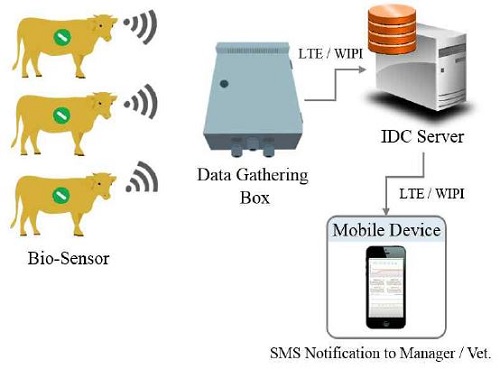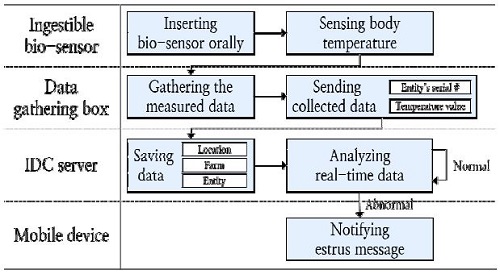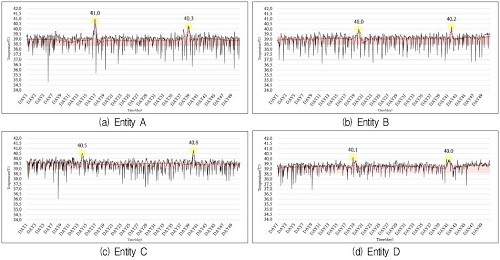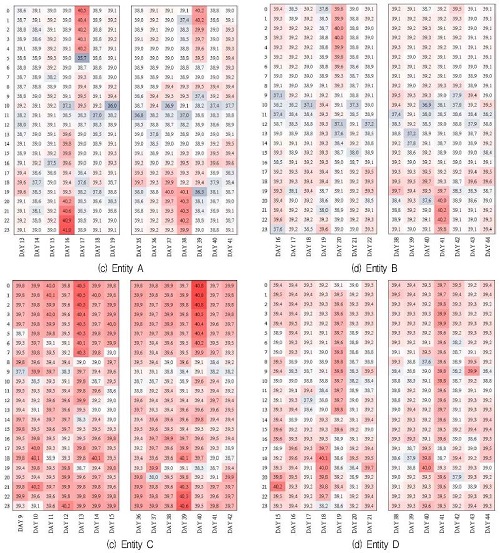
Real-time Temperature Monitoring to Enhance Estrus Detection in Cattle Utilizing Ingestible Bio-Sensors : Method & Case Studies
Abstract
In the case where stock farms fail to detect estrus, a 21-day non-pregnant period arises, causing additional feed costs for fertile cows, additional artificial insemination costs, and a decrease in calf productions and milk yield. Thus, accurately detecting cattle estrus and predicting the optimum time of insemination is very important as it is directly linked to the profit and production improvement of stock farms. In this paper, we propose a real-time temperature monitoring method for effective estrus detection and also applies it to cattle for case analysis. The ingestible bio-sensor utilized in this research settles in the cattle’s rumen and measures the core temperature without any external interference, which makes it possible to collect consistent and reliable data in real-time. With the proposed method the farm owner can detect a cattle’s estrus without fail, and predict the optimum time of insemination by confirming the onset point of estrus.
초록
축산농가에서 축우의 발정탐지에 실패하는 경우 약 21일 간의 공태가 발생하여 가임 암소의 사료비용, 인공 수정 비용, 송아지 생산 및 착유량 감소 등의 경제적 손실이 따른다. 따라서 축우의 발정을 정확히 탐지하여 수정 적기를 예측하는 것은 축산농가의 소득 및 생산성 향상과 직결되므로 매우 중요하다. 본 논문에서는 효과적인 축우의 발정 탐지를 위한 실시간 체온 모니터링 방법을 제안하고, 실제 축우에 적용해봄으로써 사례분석을 하고자 한다. 본 연구에서 사용한 경구 투여용 센서는 축우 반추위에 안착되어 외부 환경의 간섭 없이 심부 체온을 측정하므로, 실시간으로 지속적인 신뢰도 있는 데이터를 수집할 수 있다. 궁극적으로 제안하는 방법을 통해 농장주는 축우의 발정을 놓치지 않고 탐지할 수 있으며, 발정 시작 시점을 확인해 정확한 수정 적기를 예측할 수 있을 것으로 기대된다.
Keywords:
cow estrus detection, real-time monitoring, cow’s rumen temperature, ingestible bio-sensorⅠ. Introduction
Breeding management of cattle is directly connected to farm earnings. Missed inseminations due to undetected estrus result in a non-pregnant period of about 21 days. Such non-pregnant periods cause economic losses due to additional feed costs for fertile cows, artificial insemination costs, and reduced production of calves and milk yield. The optimum time of insemination for the highest pregnancy rate continues for about six hours during estrus. Thus, accurate estrus detection within a short time interval is important[1].
In general, estrus detection is performed by visual observation of standing heat. Standing heat is a representative behavioral identifier of estrus and occurs 2~3 times per hour on average. Thus in order to discover a cow in heat more than three observation periods of 30 minutes per day is necessary[1]. However, due to the Increase in herd size of large breeding farms with more than 100 cattle, there is a limit to closely observing every entity. In addition, standing heat may be scarcely noticeable or occur at night or at dawn, making it difficult to detect estrus in many cases.
The improvement of cattle’s reproduction rate requires accurate estrus detection. Thus there is a need for an automatic estrus detection technology without manual intervention. Many researches are being conducted to accurately measure the various signs of estrus that appear inside and outside the cattle’s body. Various researches were conducted to detect estrus of cattle based on physical activity, vocalization, bio-markers such as hormone levels. However, these methods had application limits in actual farm sites due to additional maintenance costs, initial introduction costs, and low estrus detection rates[2]-[4].
We monitor the rumen temperature in real-time for estrus detection. The body temperature of cattle is a highly reliable biological indicator of its general health condition and energy metabolism[5]. The normal temperature of adult cows is on average 38.5℃~39. 5℃. The daily rhythm of body temperature matures fully during the first two months of life[5][6]. The body temperature of cattle during estrus cycle shows a variation from the normal pattern. Its body temperature is slightly reduced some days before estrus, and then increases during the estrus period[5][7][8]. Thus, by monitoring the body temperature of cattle in real-time, estrus detection can be enhanced and the start of an estrus cycle can be identified to help predict the optimum time of insemination.
The real-time temperature monitoring method proposed by this paper utilizes an ingestible bio-sensor to consistently measure the rumen temperature of cattle and detect estrus based on the collected data. The estrus detection can be enhanced by accurately and consistently measuring and monitoring the core body temperature of cattle without any external interference.
The rest of the paper is organized as follows: Chapter 2 describes the related works and Chapter 3 explains the proposed real-time temperature monitoring method for estrus detection in cattle. Chapter 4 presents our field application experiment including design, results, and analysis. Finally, Chapter 5 concludes this paper with a brief summary and discussion of future works.
Ⅱ. Related works
2.1 Estrus expressions
Cattle that enter estrus cycle undergo physiological and behavioral changes due to secreted hormones before ovulation. Physiological changes during the early stages of estrus include the swelling and reddening of vulva and dilated pupils. Vaginal mucus discharges are copious and transparent, but the amount decreases and becomes less transparent towards the end of the estrus cycle. Behavioral changes include sniffing or licking another cow, and resting with the chin on the rump of another cow. Loud wails, restlessness, nervous behavior can also be witnessed, and the amount of feed intake decreases from loss of appetite, while increase in activity occurs with rise in the number of steps taken by a cow during estrus [1][9]. Changes in vocalization also occur with the cow making coarse and high, sharp sounds with great changes in amplitude[2].
The behavioral change most closely linked to estrus is mounting behavior or standing estrus and staying still for several seconds to be mounted. Cows not in standing estrus are quick to avoid from being mounted by other cows. Thus, most cows that stand to be mounted are in their estrus cycle, and half of the cows that mount other cows are in standing estrus. Mounting behavior usually arises during the mid-cycle of estrus and standing to be mounted behavior arises during the later stages of estrus, thus the optimum time of insemination is generally determined by standing behaviors[1].
Estrus is influenced by various factors such as the health condition of the cow, composition of congregation, environmental factors, etc. The estrus cycle of a poorly nourished cow grows longer and the frequency of estrus behavior decreases. High temperature and humidity reduce estrus behavior and thus in the summer season estrus behavior is difficult to observe. In the case where two or more cows start estrus simultaneously, the number of mounting behavior increases[1][9]. Mounting and standing behavior decreases in cases of longer hooved cows, slippery grounds that cause unstable postures, and concrete surfaces than dirt[1]. In addition, some cows show no particular behavioral signs of estrus and 60% of estrus cows show no mounting behaviors[10].
The duration of an estrus cycle is on average 18 hours and ovulation occurs within 8~11 hours after estrus. The optimum insemination time for the ovulated ovum lasts for six hours. Thus the optimum time of insemination for a cow is 12~18 hours after the onset of estrus or about 3~4 hours after the end of estrus[1]. Such numerical figures differ among cattle breed and even entities among the same breed. Also, the estrus cycle, estrus duration time, ovulation time, and insemination ability time of reproductive cells affect the numerical results. Detecting estrus based on physiological and behavioral changes is inaccurate and inefficient and due to the difference in reproductive cycles and estrus expressions, breeding management of cattle in groups must be accompanied with individual management.
2.2 Existing methods of estrus detection
Cattle farms usually determine estrus by visual observation of cattle behavior. Existing studies that focused on standing heat to detect estrus vary in estrus detection efficiency from less than 50% to 79% [9][11]. This is because the number and time of visual observation influences the estrus detection results. Detection aids such as couplers and crayons are used to compensate for such limitations. Color formers attached to the cow’s tail-head can be used as estrus indicators as the ink is rubbed off when it is stands to be mounted. However, this supplementary indicator is only effective in cases where cows allow to be mounted during its estrus cycle. Also, not all cattle display estrus behavior during its estrus cycle, and even some cattle with regular ovulation cycles do not show distinct estrus behavior and such weak estrus conditions are even more difficult to detect. In addition, the number of cattle in estrus at the same time influences the rate of cattle that show mounted behavior. Sniffing and chin resting are not exclusive behavioral traits of estrus[11]. Therefore, accurate estrus detection based on observing estrus behaviors is difficult due to limits in manpower and unclear estrus behavioral expressions.
There are also sensors that are attached to the body of cattle to monitor the increased activities during estrus. 3d-accelerometer sensors are attached to the cow’s leg to assess the step count and lying, standing motions. Neckbands are also used as activity tags to measure the cow’s movements[12][13]. Sensors attached to the external body of cattle can be loss or damaged during the cattle movements. In addition, the amount of activity differs among breed and is influenced by factors such as age and number of lactation. Walking activity is influenced by external conditions such as barn types and group management conditions[9][13]. In general, cows in first parities showed greater amounts of activity than cows in later parities thus limiting the accuracy of estrus detection utilizing a single activity data.
Another existing method proposes an estrus detection system based on real-time vocalization information of cattle. The acoustic features of cattle vocalizations are acquired by utilizing a sound acquisition algorithm and compared to a preset amplitude threshold to detect estrus[2]. The performance of this detection method was verified through experiments, however it lacks practicality to be realized and applied in actual farms. Also, additional researches must be conducted to secure generality in amplitude threshold for various cattle vocalizations.
Other researches include estrus detection methods based on changes in hormones. One study analyzing LH measurement found that LH surge was co-incident with estrus[4]. Another research detected estrus based on the decreased level of progesterone concentration right before estrus[14]. Such hormone detection methods showed a high accuracy of over 95%. However such methods require high initial facility costs for analysis equipment and additional manpower for sample collection and management. Also, real-time detection is impossible due to the time required for hormone analysis[9].
We propose an estrus detection method that can overcome such limitations and monitor cattle temperatures in real-time utilizing an ingestible bio-sensor.
Ⅲ. Temperature monitoring method to enhance estrus detection
3.1 Proposed method
We propose an estrus detection system utilizing an ingestible bio-sensor that measures the body temperature of cattle in real-time and thus allows accurate detection of estrus onset and its condition. Fig. 1. is the system architecture suggested by this paper. The system is configured of a bio-sensor orally inserted into the cattle, data gathering device that detects and collects real-time biometric information, IDC server that saves and manages the collected data, and mobile device with an installed mobile application that alerts the manager and veterinarian.
The accurate measurement of deep body temperature is necessary for estrus detection. Rectal temperature is most commonly used, however the cow must be secured during the measurement process requiring additional manpower and time. Temperature measurement methods with attached sensor modules can be affected by external interferences, and the movements of the cow may damage or release the sensor, harming the reliability of data. Compared to existing methods, ingestible bio-sensors safely reside in the rumen of cattle and are designed to stay in the rumen even during rumination.
While residing inside the cow, the bio-sensor can measure its deep body temperature in minute detail of 0.1℃, safe from external environmental interferences. The sensor is installed in a non-toxic capsule that protects it from gastric fluids and rumen pressure. The bio-sensor’s battery power lasts a maximum of six years that ensures stable and repetitive temperature measurements until butchery[15]. Thus, estrus detection is possible with or without estrus behavior expressions, and the accurate time of estrus onset can be detected based on temperature changes.
The normal range of cattle body temperature is known to be within 38.5℃~39.5℃. However, each entity displays differences in their normal body temperature. Thus, each entity was set up with a different range of normal body temperature by measuring its temperature while in healthy condition. The body temperature measured in real-time is compared to the normal temperature range and in the case where abnormal temperatures continue for a certain amount of time, a alarm message is sent to the farm owner.
The data record of a cow’s deep body temperature can be checked through a mobile application for entities with bio-sensors. By registering a cow’s breeding information, the manager can receive alert messages of estrus detection, insemination, and parturition schedules. Thus, without the use of additional aids such as estrus cycle charts, the manager can easily handle breeding management from estrus to parturition process. With accurate estrus detection, the optimum time of insemination can be predicted and prior preparations for fertilization, pregnancy, parturition can become possible, thus improving the productivity of cattle and increasing farm profits.
3.2 Estrus detection process
Fig. 2 is a diagram of the estrus detection process based on real-time deep body temperature measurements utilizing ingestible bio-sensors that transmit the data to the data gathering box and server.
The ingestible bio-sensor is injected through the esophagus of cattle and settles in the rumen to measure deep body temperature in real-time. Body temperature measurements of each entity are collected in the data gathering box along with the entity’s serial number. Data gathering box transmits collected data to the server and such data is categorized according to location, farm and entity, and saved in the database. At the same time, the real-time temperature is compared to the normal temperature range of each entity. When an abnormal temperature is discovered, an alarm message is immediately sent via mobile application and farm pc to the farm owner. Upon receiving a message, the owner observes the entity’s condition and determines if it is in estrus. The onset of estrus can also be detected by checking the temperature data record and predict the optimum time for insemination.
Ⅳ. Field application experiment
4.1 Field application and experiment method
We proposed a real-time temperature monitoring method utilizing an ingestible bio-sensor for effective estrus detection. This method was applied to cattle in a field experiment. The experiment period was for 50 days from May 1, 2017 to June 19, 2017, and observed two estrus cycles. Table 1 shows the information of the entities in the experiment. A total of four cows that were bred in a Korean cattle farm located in Boryeong-si city, Chungcheongnam-do province were experimented on. Two were parous cows and two were maiden cows. All four cows were not heifers, but adult cows ages 12~63 months. The estrus cycles of all entities were scheduled for mid-May according to the farm’s breeding records. At the initiation of the experiment, all cows were in healthy condition.
Before the experiment, all four cows were injected with the ingestible bio-sensors using the bolus gun. The bio-sensors were safely settled in the rumen of each cow, and during the experiment the rumen temperature measured and transmitted in real-time. In the case of abnormal temperature measurements that differed from the normal range, the farm manager received estrus alert messages via mobile application. Upon receiving such alerts, the manager observed any estrus behavior and expressions to detect estrus. In order to observe additional estrus, no special steps were taken when estrus was detected during the experimental period. The body temperature of the entities was measured in ten minute intervals and 144 temperature measurements were collected each day. Upon conclusion of the experiment, a total of more than 28,000 temperature data had been gathered.
4.2 Experimental results and analysis
None of the entities showed any unusual behaviors or physical side-effects after the bio-sensors were injected. At the end of the experiment, all four cows were in healthy condition. During the 50-day experiment period, all four bio-sensors measured each entity’s temperature in a stable manner without being damaged or loss from rumination or defecation. Table 2 is a summary of the experiment results. A total of eight estruses were detected from the four cows, and the average estrus cycle was 23.3 days. The average body temperature of the entities was 38.9℃~39.5℃, with each entity showing slight differences in temperature. However, each entity’s body temperature was within the normal temperature range of 38. 5℃~39.5℃. Thus, the ingestible bio-sensor accurately measured the deep body temperature of the cows.
Fig. 3 is a graph of the daily average temperature of each entity measured by each bio-sensor. This daily graph shows that the body temperature of the cows was measured in a stable manner during the 50-day experiment period.
Fig. 4 is a more detailed graph showing the temperature change of each entity during the 50-day-experiment. The collected temperature data was calculated to display the average temperature per hour of each entity. This graph clearly shows the temperature change of each entity in estrus.
Fig. 4(a) shows the body temperature changes of entity A. According to the graph, entity A’s temperature rose on DAY16 and DAY38 due to estrus. During the initial estrus, entity A’s average temperature was 40.1℃, and during the second estrus its average temperature was 40.0℃. The average temperature of entity A during the 50-day-experiment was 38.9℃. Its temperature rose about 1.1℃ during estrus, the largest temperature rise among the four entities. Its highest body temperature during estrus recorded 41℃, the highest among the four entities. Its additional estrus cycle was 22-days-long which matched the average, normal estrus cycle.
Fig. 4(b) shows the body temperature changes of entity B and its temperature rose on DAY19 and DAY41 due to estrus onset. During the initial estrus, its average temperature was 39.8℃, and during the second estrus its average temperature was also 39.8℃. The average temperature of entity B during the 50-day-experiment was 39.0℃. Its temperature rose about 0.8℃ during estrus, marking a clear temperature rise due to estrus. Its additional estrus cycle was 22-days-long, the same as entity A, and matched the average estrus cycle.
Fig. 4(c) displays the body temperature changes of entity C, and its temperature rose on DAY12 and DAY39 due to estrus. During the initial estrus, its average temperature measured 40.3℃, and during the second estrus its average temperature was 40.5℃. The average temperature of entity C was 39.5℃, the highest among the four entities. Its average temperature during estrus was also highest at 40.4℃. This was a 0.9℃ rise from its average temperature, making it the second highest rise among the four entities. Its additional estrus cycle was a bit long, at 26 days.
Fig. 4(d) is the body temperature graph of entity D, and its temperature rose on DAY18 and DAY41 due to estrus. During the initial estrus, its average temperature measured 39.3℃, and during the second estrus its average temperature was also 39.3℃. The average temperature of entity D was 39.2℃. Its average temperature during estrus rose by 0.5℃, the smallest increase among the four entities. However, a temperature rise could still be detected. Entity D’s additional estrus cycle length was 23 days, also matching the average estrus cycle.
Fig. 5 is a color graph displaying the temperatures of each entity indicating temperatures 3-days prior to estrus, estrus day, 3-days after estrus. The vertical axis shows the hours from 0:00 to 23:00. The horizontal axis displays the dates.
The hourly temperature is an average of the measured temperatures in 10-minutes intervals. The intensity of the red color represents higher temperature, while the blue color shows the lower temperature in differences of 0.1℃ to intuitively express the temperature change. During the 50 days, each of the four entities experienced two estruses. Each estrus cycle was seven days which totaled to 14 days of temperature data. All eight estrus cases can be seen on the graph in distinct red color blocks. Temperature rise continued for a minimum of six to a maximum of 20 hours and differed among entities, showing the difference in estrus continuation time. Estrus cycles also differed among entities. In addition, blue data are usually displayed during the morning times of 9~11AM. This was due to drinking actions of entities that temporarily lowered the rumen temperature.
Experiment results show that ingestible bio-sensors accurately measured deep body temperature up to 0. 1℃ differences, and with real-time monitoring the estrus of each entity was effectively detected. The temperature changes of the four experiment entities were monitored and this allowed accurate estrus detections. In addition, unlike existing observation methods of mounting activities that could not detect weak estrus or estrus onset during late-night or dawn times, accurate estrus onset period could be detected with temperature records.
Ⅴ. Conclusion and future work
Farmhouses in general detect estruses by visual observations or with aid methods that assess estrus behaviors. However, weak estruses or estrus periods that occur late at night or at dawn make it difficult to detect estrus in cows and predict the optimum insemination period. Several researches have been conducted utilizing indicators such as activity amount, vocalization, and internal hormone analysis to automatically detect cattle estruses without the interference of humans. However, such methods lack practicality to be actually applied to real stock farms.
We proposed an ingestible bio-sensor that monitors body temperature in real-time as an effective estrus detection method. The ingestible bio-sensor settles in the cow’s rumen and can monitor subtle temperature changes without external environmental interferences. This allows for real-time temperature measurement of cattle which leads to accurate and swift estrus detection.
We conducted an experiment on four Korean cattle that were injected with ingestible bio-sensors and monitored for 50 days. As a result, the four injected bio-sensors showed accurate measurements of deep body temperature of the entities in real-time. And based on such temperature data, a total of eight estrus cases were detected. The average temperature rise during estrus of each entity was 1.1℃, 0.8℃, 0.9℃, 0.5℃, showing a rise in each entity’s temperature during estrus. With real-time temperature monitoring, the temperature changes of each entity during estrus could be rapidly checked, and the estrus onset period was accurately detected utilizing the temperature records.
In addition to effective estrus detection, we will focus on contributing to higher fecundity rates in the future. Real-time temperature monitoring with ingestible bio-sensors can detect estrus and also pinpoint the exact onset period of estrus. Thus, the predicted optimum period of insemination can gain reliability and ultimately increase the fecundity rate of cattle.
Acknowledgments
This work was supported by Korea Institute of Planning and Evaluation for Technology in Food, Agriculture, Forestry(IPET) through Advanced Production Technology Development Program, funded by Ministry of Agriculture, Food and Rural Affairs(MAFRA)(316078-03).
References
- The Korean Society of Embryo Transfer, "The latest reproductive skills of cattle", WORLD SCIENCE, p64-75, May), (2005.
-
K. J. In, J. U. Lee, Z. S. Xu, D. H. Park, Y. W. Chung, and H. H. Chang, "Real-time Vocalization Aquisition and Oestrus Detection of Korean Native Cows", Journal of Korean Institute of Information Technology, 13(12), p123-132, Dec), (2015.
[https://doi.org/10.14801/jkiit.2015.13.12.123]

- H. G. Kim, S. K. Jeoung, and H. Yoe, "Design of Acceleration Sensor Node for Detection of Livestock Estrus", Proc. of Symposium of the Korean Institute of communications and Information Sciences, 2013(11), p147-148, Nov), (2013.
-
A. D. Fisher, R Morton, J. M. A. Dempsey, J. M. Henshall, & J. R. Hill, "Evaluation of a new approach for the estimation of the time of the LH surge in dairy cows using vaginal temperature and electrodeless conductivity measurements", Theriogenology, 70(7), p1065-1074, Jun), (2008.
[https://doi.org/10.1016/j.theriogenology.2008.06.023]

- G. Piccione, C. Giovanni, and R. Roberto, "Daily and estrous rhythmicity of body temperature in domestic cattle", BMC physiology, 3(1), p7, Jul), (2003.
- H. J. Kim, and S. H. Ahn, "Estrus Detection Method by Case Study for Cattle using Ingestible Sensor", Proceedings of the 2016 Korea Multimedia Society Fall Conference, 19(2), p1324-1325, Oct), (2016.
-
R. Firk, E. Stamer, W. Junge, and J. Krieter, "Automation of oestrus detection in dairy cows: a review", Livestock Production Science, 75(3), p219-232, Jul), (2002.
[https://doi.org/10.1016/s0301-6226(01)00323-2]

-
V. S. Suthar, O. Burfeind, J. S. Patel, A. J. Dhami, and W. Heuwieser, "Body temperature around induced estrus in dairy cows", Journal of dairy science, 94(5), p2368-2373, May), (2011.
[https://doi.org/10.3168/jds.2010-3858]

-
J. Roelofs, F. Lopez-Gatius, R. H. F. Hunter, F. J. C. M. Van Eerdenburg, and C. Hanzen, "When is a cow in estrus? Clinical and practical aspects", Theriogenology, 74(3), p327-344, Feb), (2010.
[https://doi.org/10.1016/j.theriogenology.2010.02.016]

-
M. Saint-Dizier, and S. Chastant-Maillard, "Towards an automated detection of oestrus in dairy cattle", Reproduction in domestic animals, 47(6), p1056-1061, Jan), (2012.
[https://doi.org/10.1111/j.1439-0531.2011.01971.x]

-
J. B. Roelofs, F. J. C. M. Van Eerdenburg, N. M. Soede, and B. Kemp, "Various behavioral signs of estrous and their relationship with time of ovulation in dairy cattle", Theriogenology, 63(5), p1366-1377, Mar), (2005.
[https://doi.org/10.1016/j.theriogenology.2004.07.009]

- R. Jónsson, M. Blanke, N. K. Poulsen, F. Caponetti, and S. Højsgaard, "Oestrus detection in dairy cows from activity and lying data using on-line individual models", Computers and electronics in agriculture, 76(1), p6-15, Mar), (2011.
- P. Løvendahl, and M. G. G. Chagunda, "On the use of physical activity monitoring for estrus detection in dairy cows", Journal of Dairy Science, 93(1), p249-259, Jan), (2010.
-
N. Friggens, M. Bjerring, C. Ridder, S. Hojsgaard, and T. Larsen, "Improved detection of reproductive status in dairy cows using milk progesterone measurements", Reproduction in Domestic Animals, 43(s2), p113-121, Jul), (2008.
[https://doi.org/10.1111/j.1439-0531.2008.01150.x]

-
H. J. Kim, S. E. Oh, S. H. Ahn, and B. J. Choi, "Real-time Monitoring Method of Cattle’s Temperature for FMD Prevention and Its Case Studies", Journal of KIIT, 15(5), p141-150, May), (2017.
[https://doi.org/10.14801/jkiit.2017.15.5.141]


2005 : B.S., 2007 : M.S., 2017 : Ph.D. degrees in Dept. of Computer Science and Engineering, Ewha Womans University, Korea.
2011 ~ present : CEO, uLikeKorea Co., Inc.
Research interests : Software Testing, Ag-Tech, IoT, Big Data Analysis

2016 : B.S. degree in Dept. of Computer Science and Engineering, Ewha Womans University, Korea.
2016 ~ present : M.S. stuent, Dept. of Computer Science and Engineering, Ewha Womans University, Korea.
Research interests : Software Engineering, Software Testing, IoT

2007 : B.S. degree in Dept. of Multimedia Engineering, Dongseo University, Korea.
2015 ~ present : Senior researcher, uLikeKorea Co., Inc.
Research interests : Sensor Network, IoT, Big Data Analysis

1983 : B.S. degree in Dept. of Mathematics, Ewha Womans University, Korea.
1988 : M.S., 1990 : Ph.D degrees in Dept. of Computer Science, Purdue University, USA
1995 ~ present : Professor in Dept. of Computer Science and Engineering, Ewha Womans University, Korea.
Research interests : Software Engineering, Software Testing, IoT, Big Data System Quality






